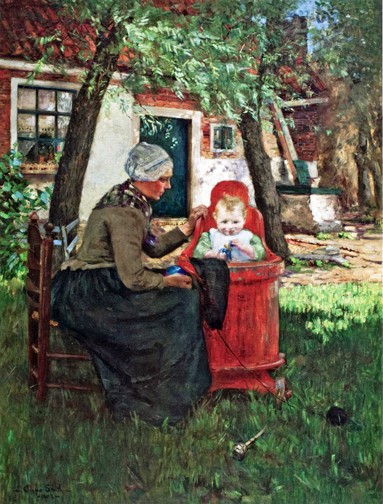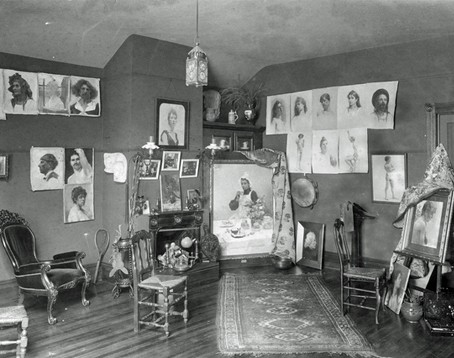Letta Crapo Smith, 1862 – 1921
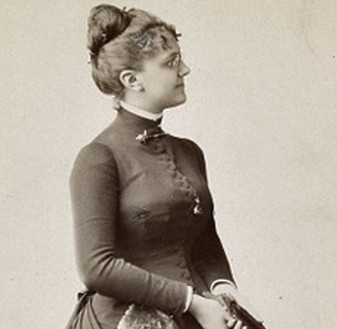
Henrietta (Letta) Crapo Smith was a painter from a prominent Michigan family (her grandfather, Henry H. Crapo, was Governor of Michigan from 1865-1869). She counted among her ancestors passengers on the Mayflower and Minute Men who served in the Continental Army, defeating the British in the Revolutionary War. Though Smith was born in Flint, Michigan, a city founded by her cousin, she spent most of her childhood in elite social circles in Detroit. Another cousin, William Crapo Durant, known as Billy Durant, was an industrial pioneer, co-founding General Motors, Chevrolet, and Frigidaire.
In 1890, Letta went to study in Paris at the Académie Julian, where she was critiqued by William-Adolphe Bouguereau and Tony Robert-Fleury. She became the first woman artist from Detroit to have her work accepted at the Salon des artistes français, when her painting called “Toute seule!” was exhibited in 1890. Her address in the Salon catalogue was listed as 235 rue du Faubourg Saint-Honoré.
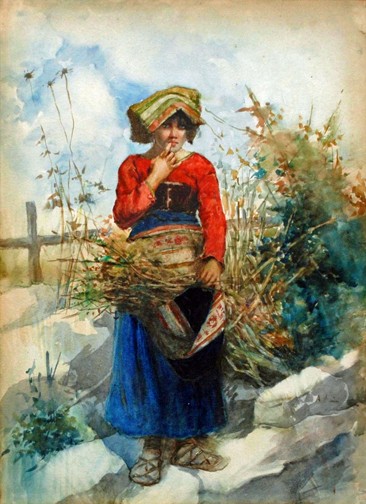
In 1891, Smith’s drawing of jonquils was accepted into the Salon and, in 1893, she showed two drawings as well as a painting. Around 1892, Smith returned briefly to the United States to study in New York with William Merritt Chase (Falk 3085). The next year, in 1894, she exhibited a pastel of a Dutch house at the Salon. Known for her striking ability as a colorist, Smith also gained success showing her paintings in the United States. Her work appeared in the Woman's Building at the 1893 Columbian Exposition in Chicago and she frequently participated in Art Institute of Chicago exhibitions from 1896-1912.
It seems that Smith moved around Paris quite frequently, eventually settling at the Girls’ Art Club at 4 rue de Chevreuse—she was among the artists listed as Club residents in the 1896 Indicateur guide to artistic Paris. After a brief Salon hiatus, Smith began exhibiting at the newer Salon des Beaux Arts starting in 1902, when she showed a drawing of chrysanthemums and a painting called “Une fille d’Egmond,” which was hung on the line (Stott 96). In 1903, she exhibited her famed painting “The First Birthday” at the Salon des Beaux Arts. Her last Salon appearance, again at the Salon des Beaux Arts, came in 1908, when her painting of a sunny window was featured.
Smith spent the summers of 1901 and 1902 in the Netherlands, training at George Hitchcock's summer school in Egmond, where she refined her skills and painted larger canvases than she had previously produced, all en plein air (Dutch Utopia 232). Other women artists who were affiliated with Hitchcock’s Egmond colony were fellow Girls’ Art Club affiliates Wilhelmina Douglas Hawley, Elizabeth Nourse, and Alice Blair Ring (Dutch Utopia 30). While in Egmond, Smith was “fortunate enough to rent a studio in a building that a local Dutchman had constructed specifically for the use of artists” (Stott 95). "The First Birthday" was executed during this period, capturing the daily life of Dutch residents in the town. "The First Birthday" has had a storied history after first being exhibited at the Salon des artistes français in 1903. It won a bronze medal at the St. Louis Exposition and was displayed at the Louvre for a short period of time and at the Detroit Institute of Arts on a long-term loan. When the painting arrived at the Detroit Institute of Arts in 1907, a brief article about Smith was published in the museum’s Bulletin. The painting was highly praised: “The variegated notes, --the red crib, the greens in sunlight and shadow, the dull tones of the matron’s dress, and the dull red of the tile and brick of the house, all combine to form one general tone with which no single note conflicts” (3). It is now in the permanent collection of the Flint Institute of Arts.
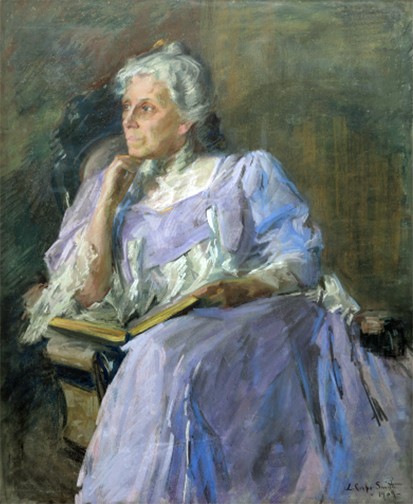
During her nearly two decades abroad, Smith’s parents frequently visited their daughter and she would often go off on adventures with her mother in Italy, Sicily, England, and other parts of France. Their journeys were chronicled in the society pages of several newspapers, including The New York Herald European edition.

Smith returned to the United States around 1906 and created an art studio in her parents' Detroit home at 789 Jefferson Avenue (Stott 95). She worked closely with painter Julius Rolshoven, another important Detroit artist and Académie Julian alumnus, and she participated in a number of exhibitions.

In May 1906, the Girl’s Friendly Society of Michigan hosted their annual fundraising fair in Detroit with a Japanese theme and Letta Crapo Smith was enlisted to design the pagoda and decorations. According to the Detroit Free Press, because she had “spent much time in Japan, they will be absolutely correct in every detail” (May 13, 1906, 45). It is unclear exactly when Smith had been in Japan but perhaps she crossed paths with another Girls’ Art Club alumna, Blondelle Malone, who visited Japan in 1903.
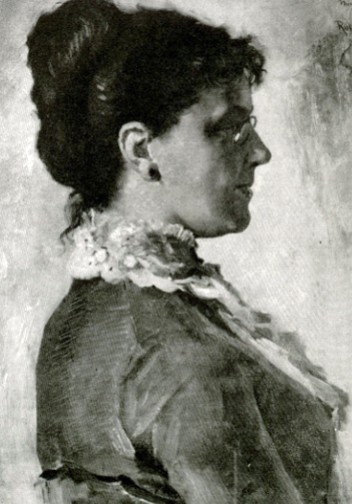
Smith became president of the Detroit Society of Women Painters in 1907, a position she would hold several times until 1915, when tuberculosis forced her to give up painting and retire from public life (Biographical Sketches 226). Before her illness became uncontrollable, Smith received a rave review in a March 2, 1910 article in the Detroit Free Press about the Society’s annual exhibition. At that time, she was serving as its vice president and was declared the “artist par excellence of the group.” Her work stood out for “beauty, strength and originality” with one painting of a rose garden described as “full of charm” and a pastel simply characterized as “a thing of beauty” (7). At least two other exhibitors had also been affiliated with the Girls’ Art Club: twin sisters and Detroit natives Della and Lillie Garretson.
Smith never married or had children. When she died in 1921, she was buried alongside her parents in Flint. Her family’s papers are accessible at the University of Michigan-Flint’s Thompson Library. The Thompson Library also features the Crapo room, a 19th-century office replica honoring her grandfather, Henry Howland Crapo, former Michigan governor and university alumnus. Inside the Crapo room hangs an oil painting by Letta Crapo Smith, “Taormina.”
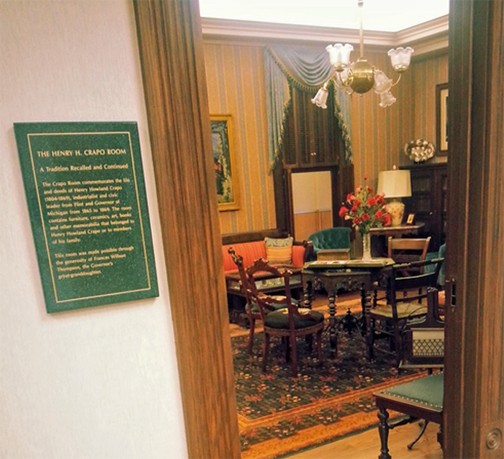
Sources
- Dutch Utopia: American artists in Holland, 1880-1914. Ed. Annette Stott. Savannah, Georgia: Telfair Books, 2009.
- Falk, Peter H. “Smith, Letta Crapo.” Who Was Who in American Art 1564-1975: 400 Years of Art in America, volume 3. Madison, CT: Sound View Press, 1999, p. 3085.
- Moore, Julia Gatlin. History of the Detroit Society of Women Painters and Sculptors, 1903-1953. Detroit: Victory Printing Co., 1953, p. 26.
- “New Pictures in the Galleries.” Bulletin of the Detroit Museum of Art, vol. 1, no. 14, July 1907, p. 3. JSTOR.
- “Smith, Letta Crapo.” Biographical Sketches of American Artists, 3rd edition. Lansing: Michigan State Library, 1915, p. 226.
- “Society.” Detroit Free Press, May 13, 1906, p. 45. ProQuest Historical Newspapers.
- "Women's Paintings at Museum of Art." Detroit Free Press, March 2, 1910, p. 7. ProQuest Historical Newspapers.
